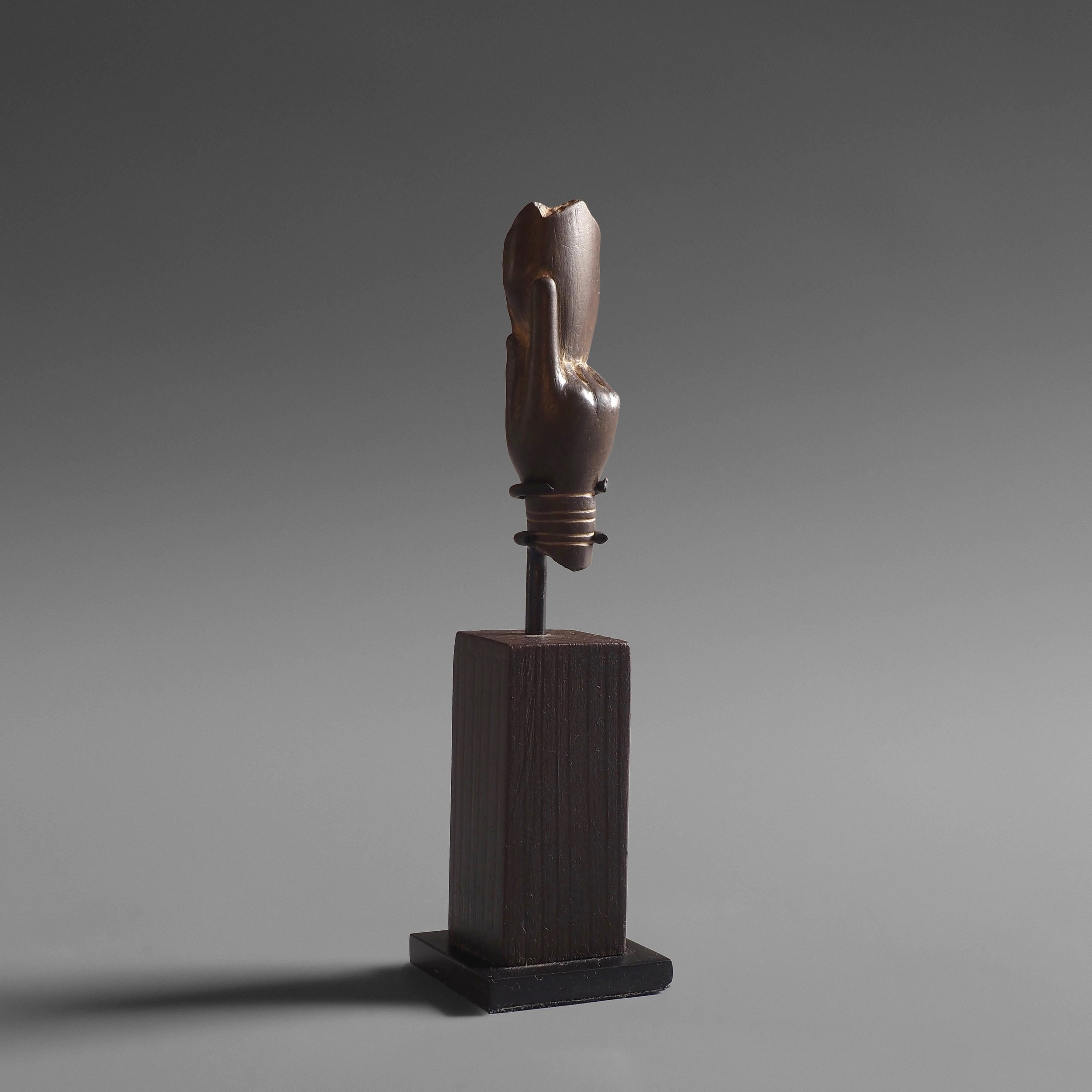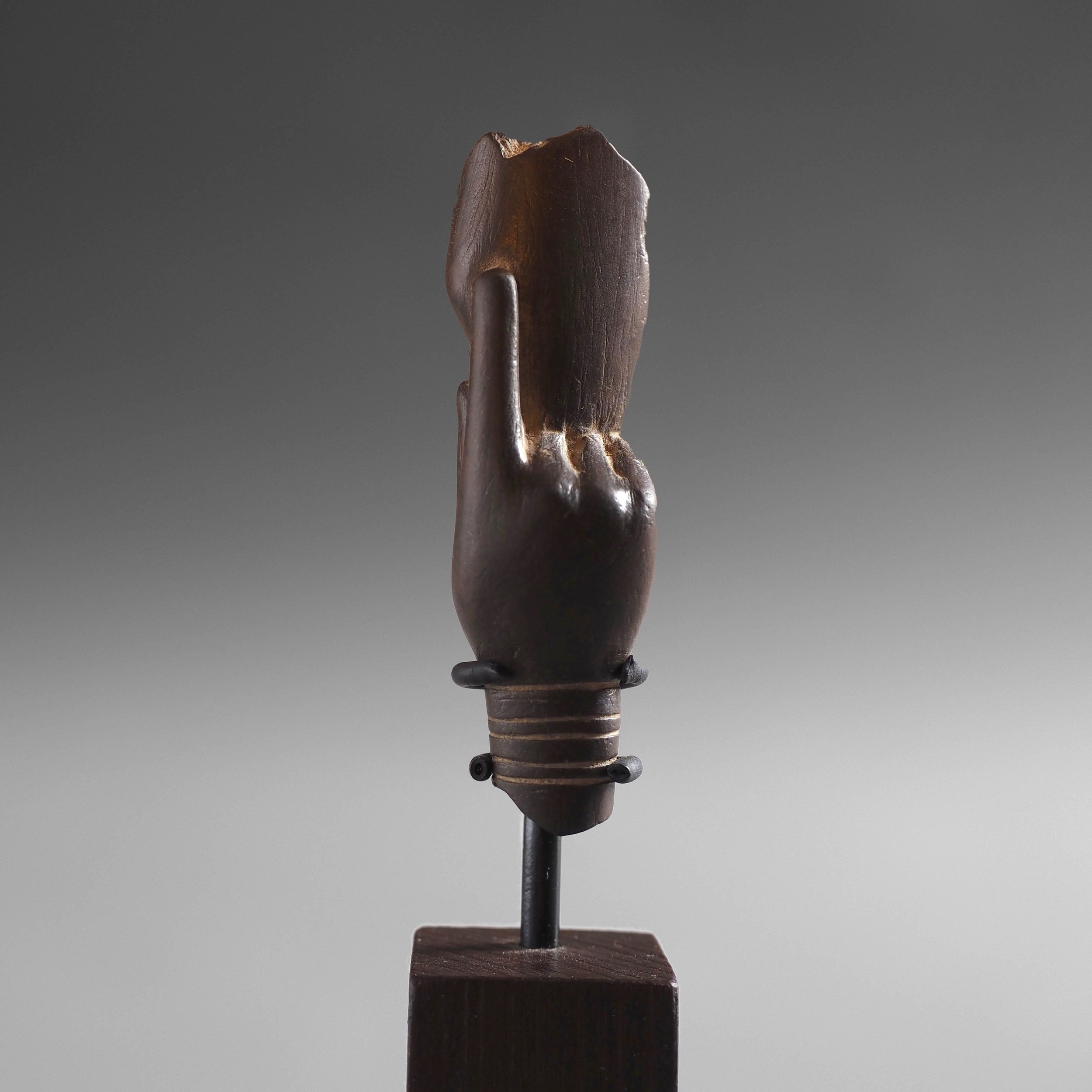Cosmetic spoon Fragment
Ancient Egyptian, New Kingdom, c. 1550
- 1069 B.C., Brown Steatite, 6 cm long x 1.5 cm wide
Provenance:
Private Collection of Professor Hans Goedicke (1926-2015), acquired in Egypt between 1956-1958;
Christie's London, Antiquities:
'Property sold to benefit The Hans Goedicke Foundation for Egyptology' 25th April 2007, lot 74;
Prince Saud bin Muhammed Al Thani (1966 - 2014);
Thence by descent.
£2, 500





This exquisite fragment of an Egyptian cosmetic spoon takes the form of a hand, with an outstretched index finger. The finger supports a tear-drop shaped spoon, and is configured as if in the act of applying make up with a degree of precision. The wrist is adorned with a spiral bracelet, before it is broken off at the forearm, at the point it would have extended into the spoon’s handle. The design of several Egyptian cosmetic spoons that survive in museum collections involve a similar anthropomorphic conceit. For example, some feature full figure representations of Hathor, the goddess of beauty and patron of cosmetics, whilst some take the form of a finger, or a hand with an open palm. In ancient Egypt, the wearing of cosmetics was seen as a form of worship to Hathor and offerings of mirrors or cosmetic palettes were often made in her honour. Once thought to be simple toilet items, these so-called ‘cosmetic spoons’ are now thought to be ritual items, rich with iconography connecting them to fertility and rites of renewal.
This object hails from the great collection of the late Prince Saud bin Muhammed Al Thani (1966 – 2014), who was regarded as one of the most discerning, knowledgeable and prolific collectors of his generation. He once said:
"I buy masterpieces pieces from an important church, a major family, a great collection, these really interest me: they have a history and a provenance. You can get them in the best possible condition, and there are no problems of authenticity.”

Spoon, Ancient Egyptian, New Kingdom, c. 1550–1295 B.C., 18th Dynasty, Memphite Region, Saqqara, Teti Pyramid Cemetery, Tomb of Tjetji, Wood. 24.5 cm long, 3.9 cm wide, 1 cm deep. Metropolitan Museum of Art, New York

Spoon, Ancient Egyptian, New Kingdom, c. 1550–1295 B.C., 18th Dynasty, Memphite Region, Saqqara, Teti Pyramid Cemetery, Tomb of Tjetji, Wood. 24.5 cm long, 3.9 cm wide, 1 cm deep. Metropolitan Museum of Art, New York

Cosmetic spoon, Ancient Egyptian, New Kingdom c. 1550–1295 B.C., 18th Dynasty, Bone, 7.5 cm high, 1.3 cm wide. Metropolitan Museum of Art, New York.

Cosmetic spoon, Ancient Egyptian, New Kingdom c. 1550–1295 B.C., 18th Dynasty, Bone, 7.5 cm high, 1.3 cm wide. Metropolitan Museum of Art, New York.

Finger-shaped Cosmetic Scoop, Ancient Egypt, Middle Kingdom, c. 1981–1640 B.C. 12th – 13th Dynasty, Travertine (Egyptian alabaster), 7.8 cm long. Metropolitan Museum of Art, New York.

Cosmetic Spoon, Ancient Egypt, Second Intermediate Period–New Kingdom, 17th – 18th Dynasty, c. 1600–1500 B.C. Wood, 20.7 cm long. Metropolitan Museum of Art, New York.
